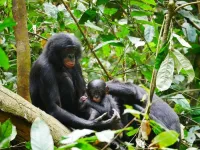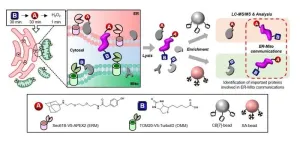(Press-News.org) Chimpanzees and bonobos are often thought to reflect two different sides of human nature—the conflict-ready chimpanzee versus the peaceful bonobo—but a new study publishing April 12 in the journal Current Biology shows that, within their own communities, male bonobos are more frequently aggressive than male chimpanzees. For both species, more aggressive males had more mating opportunities.
“Chimpanzees and bonobos use aggression in different ways for specific reasons,” says anthropologist and lead author Maud Mouginot of Boston University. “The idea is not to invalidate the image of bonobos being peaceful—the idea is that there is a lot more complexity in both species.”
Though previous studies have investigated aggression in bonobos and chimpanzees, this is the first study to directly compare the species’ behavior using the same field methods. The researchers focused on male aggression, which is often tied to reproduction, but they note that female bonobos and chimpanzees are not passive, and their aggression warrants its own future research.
To compare bonobo and chimpanzee aggression, the team scrutinized rates of male aggression in three bonobo communities at the Kokolopori Bonobo Reserve (Democratic Republic of Congo) and two chimpanzee communities at Gombe National Park (Tanzania). Overall, they examined the behavior of 12 bonobos and 14 chimpanzees by conducting “focal follows,” which involved tracking one individual’s behavior for an entire day and taking note of how often they engaged in aggressive interactions, who these interactions were with, and whether they were physical or not (e.g., whether the aggressor engaged in pushing and biting or simply chased their adversary).
“You go to their nests and wait for them to wake up and then you just follow them the entire day— from the moment they wake up to the moment they go to sleep at night—and record everything they do,” says Mouginot.
To their surprise, the researchers found that male bonobos were more frequently aggressive than chimpanzees. Overall, bonobos engaged in 2.8 times more aggressive interactions and 3 times as many physical aggressions.
While male bonobos were almost exclusively aggressive toward other males, chimpanzees were more likely to act aggressively toward females. Chimpanzee aggression was also more likely to involve “coalitions” of males (13.2% vs. 1% of bonobo aggressions). The researchers think that these coalitions might be one reason why aggression is less frequent among chimpanzees. Altercations involving groups of males have the potential to cause more injuries, and within-community fighting could also weaken the group’s ability to fight off other groups of chimpanzees. Bonobos don’t have this issue because most of their disputes are one on one, they have never been observed to kill one another, and they are not thought to be territorial, which leaves their communities free to bicker among themselves.
For both chimpanzees and bonobos, more aggressive males had greater mating success. The researchers were surprised to find this in bonobos, which have a co-dominant social dynamic in which females often outrank males, compared to chimpanzees, which have male-dominated hierarchies in which male coalitions coerce females into mating.
“Male bonobos that are more aggressive obtain more copulations with females, which is something that we would not expect,” said Mouginot. “It means that females do not necessarily go for nicer males.”
These findings partially contradict a prevailing hypothesis in primate and anthropological behavior—the self-domesticating hypothesis—which posits that aggression has been selected against in bonobos and humans but not chimpanzees.
The researchers were not able to assess the severity of aggressive interactions in terms of whether they resulted in wounds or injuries, but this is data that they hope to collect in future. They also want to compare aggressive behavior in other groups of chimpanzees and bonobos as it’s possible that behavior varies between communities and subspecies.
“I'd love to have the study complemented with comparable data from other field sites so we can get a broader understanding of variation within and between species,” says Mouginot.
###
This research was supported by Harvard University, Duke University, Franklin and Marshall College, George Washington University, the University of Minnesota, the Max Planck Society, the Institute for Advanced Study Toulouse, the Leakey Foundation, the National Institutes of Health, the National Science Foundation, the Arcus Foundation, Carnegie Corporation, the Leo S. Guthman Foundation, Margo Marsh, Mazuri, the Morris Animal Foundation, the National Geographic Society, the Harris Steel Group, the Waitt Foundation, the William T. Grant Q12 Foundation, the Windibrow Foundation, and the Jane Goodall Institute.
Current Biology, Mouginot et al., “Differences in expression of male aggression between wild bonobos and chimpanzees” https://www.cell.com/current-biology/fulltext/S0960-9822(24)00253-7
Current Biology (@CurrentBiology), published by Cell Press, is a bimonthly journal that features papers across all areas of biology. Current Biology strives to foster communication across fields of biology, both by publishing important findings of general interest and through highly accessible front matter for non-specialists. Visit http://www.cell.com/current-biology. To receive Cell Press media alerts, contact press@cell.com.
END
A deep dive into macroalgae genetics has uncovered the genetic underpinnings that enabled macroalgae, or “seaweed,” to evolve multicellularity. Three lineages of macroalgae developed multicellularity independently and during very different time periods by acquiring genes that enable cell adhesion, extracellular matrix formation, and cell differentiation, researchers report April 12 in the journal Molecular Plant. Surprisingly, many of these multicellular-enabling genes had viral origins. The study, which increased the total number of sequenced macroalgal genomes from 14 to 124, is the first to investigate ...
Melanoma is the deadliest form of skin cancer. With global incidence rates rising, new, more effective treatments are necessary to alleviate the health burden of the disease. Important advances in recent years include doctors using genetic tests to look for specific mutations they can target for more personalised, effective treatment.
Around 1 in 2 melanoma patients will have mutations in the BRAF gene. This gene normally makes a protein which helps control cell growth, but mutations can cause the cells to grow and divide uncontrollably instead, happening in many different types of cancer including ...
It is one of the world’s most spectacular sights – huge flocks or “flamboyances” of flamingos around East Africa’s lakes – as seen in the film Out of Africa or David Attenborough’s A Perfect Planet.
But new research led by King’s College London has revealed how the lesser flamingo is at danger of being flushed out of its historic feeding grounds, with serious consequences for the future of the species.
For the first time satellite earth observation data has been used to study all the key flamingo feeding lakes in Ethiopia, Kenya and Tanzania over two decades and it identified how rising ...
About The Study: In this study of National Immunization Survey–Child data, improvements in vaccination timeliness were observed from the 2011 to the 2021 survey. However, widening disparities by socioeconomic indicators signal that increased efforts to facilitate timely vaccination among children in lower-income families are needed.
Authors: Sophia R. Newcomer, Ph.D., M.P.H., of the University of Montana, Missoula, is the corresponding author.
To access the embargoed study: Visit our For The Media website at this ...
About The Study: Researchers observed an abrupt increase in permanent contraception procedures among adults ages 18 to 30 following Dobbs. The increase in procedures for female patients was double that for male patients. These patterns offer insights into the gendered dynamics of permanent contraceptive use and may reflect the disproportionate health, social, and economic consequences of compulsory pregnancy on women and people with the capacity to become pregnant.
Authors: Jacqueline E. Ellison, Ph.D., of the University of Pittsburgh School of Public Health, is the corresponding author.
To access the embargoed study: Visit our For The Media website ...
About The Study: The results of this study suggest that endoscopic sleeve gastroplasty is cost saving compared with semaglutide in the treatment of class II obesity. On price threshold analyses, a 3-fold decrease in the price of semaglutide is needed to achieve nondominance.
Authors: Christopher C. Thompson, M.D., M.Sc., of Brigham and Women’s Hospital in Boston, is the corresponding author.
To access the embargoed study: Visit our For The Media website at this link https://media.jamanetwork.com/
(doi:10.1001/jamanetworkopen.2024.6221)
Editor’s Note: Please ...
The first study to evaluate the effect of the Dobbs v. Jackson Women's Health Organization ruling on permanent contraception procedures among young adults nationwide was published today in a JAMA Health Forum research letter.
The study, authored by policy researchers from the University of Pittsburgh School of Public Health and Boston University, underscores how the 2022 U.S. Supreme Court ruling changed preferences for permanent contraception among people ages 18 to 30, who are more likely to have abortions and are also more likely to experience sterilization regret compared to people over 30.
The study is also the first to assess how the Dobbs ruling ...
Approximately one in seven couples face difficulties conceiving a child naturally. Half of these cases are due to male infertility – either caused by the complete absence or low number of mature sperm. In today’s clinical practice, over half of these cases remain unexplained, hindering optimal counselling, treatment, and prevention of potential comorbidities. Known genetic factors account for ~10% of male infertility; however, it is believed that a large portion of unexplained cases of spermatogenic failure are caused by genetic defects that ...
In cellular biology, unraveling the complexities of cellular function at the molecular level remains a paramount endeavor. Significant scientific focus has been placed on understanding the interactions at organelle contact sites, especially between mitochondria and the endoplasmic reticulum (ER). These sites are critical hubs for the exchange of essential biomolecules, such as lipids and calcium, which are vital for maintaining cellular homeostasis. Disruptions in this inter-organelle communication are implicated in the onset ...
A fleeting visit of the ESA/JAXA BepiColombo mission to Venus has revealed surprising insights into how gases are stripped away from the upper layers of the planet’s atmosphere.
Detections in a previously unexplored region of Venus’s magnetic environment show that carbon and oxygen are being accelerated to speeds where they can escape the planet’s gravitational pull. The results have been published today in the journal Nature Astronomy.
Lina Hadid, CNRS researcher at the Plasma Physics Laboratory (LPP) and lead author of the study said: “This is the first time ...




